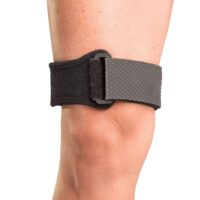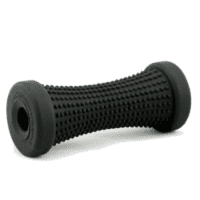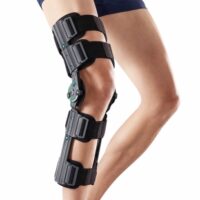
Quadriceps Tendinopathy
What is Quadriceps Tendinopathy?
Quadriceps Tendinopathy is a condition in which pain emanates from the collagen fibres that compose the quadriceps tendon as it inserts onto the top of the patella.
Who Suffers from Quadriceps Tendinopathy?
Quadriceps Tendinopathy occurs most commonly in a number of athletic populations where training programs involve excessive, repetitive or prolonged loading of the quadriceps tendon. These populations include:
- Athletes of all ages who participate in activities requiring large amounts of plyometric activity including: running, jumping and hopping eg. volleyballers and soccer players.
- Middle aged athletes who participate in activities requiring large amounts of quadriceps loading including: squatting and lunging eg. weight lifters and fencers.
What are the Signs and Symptoms of Quadriceps Tendinopathy?
Quadriceps Tendinopathy often presents with a gradual onset of pain and is less likely to occur with acute trauma, for example; a change in the type, quantity or weight lifted during an activity or training program.
Symptoms of Quadriceps Tendinopathy as a result of gradual onset include:
- Pain in the form of a dull ache that worsens with activity.
- Pain and swelling that is located at the front of the knee, specifically where the quadriceps tendon inserts onto the top of the knee cap.
Quadriceps Tendinopathy can also present due to acute trauma. In these cases the symptoms are similar to that of a Quadriceps Tendinopathy resulting from overuse, however, the mechanism of injury will be different and is usually the result of a direct blunt knock to the front of the the knee. (Brukner & Khan, 2006; Ferretti, 2015; Giombini, et al., 2013)
Why Does Quadriceps Tendinopathy Occur?
The quadriceps muscle is designed to assist with movement of the hip and knee joints. In fact, the role of the quadriceps muscle is to allow the thigh to bend at the hip joint, as well allowing the leg to straighten at the knee joint. This in turn enables us to perform activities such as: standing up out of a chair, squatting, running, hopping and jumping. Through the process of enabling movement, forces are transferred through the quadriceps tendon as it inserts onto the top of the knee cap.
The quadriceps tendon, like any other tendon in the body, becomes accustomed to a certain amount of loading to assist with movement. However, if this loading is dramatically increased over a short time period without time to adjust, or if an insult occurs to the quadriceps tendon that lowers its ability to tolerate load without adequate time to heal, the quadriceps tendon can become overused. Overuse results in damage to the collagen fibres which make up the tendon. This damage leads to the tendon being unable to perform its role, which in turn leads to further changes in the structure of the tendon, ultimately leading to pain and dysfunction.
What are the Risk Factors of Quadriceps Tendinopathy?
There are a number of factors that can contribute to Quadriceps tendinopathy including:
Intrinsic Factors
- Gender
- Age
- Previous Injury
- Stiff Joints
- Tight or Weak Muscles
- Poor Foot Control
Extrinsic Factors
- Incorrect Training Technique
- Recent Changes to Training Programs
- Training Activities
- Training Environment
- Amount of Training
- Training Equipment
- Fatigue
- Inadequate Warm Up and Cool Down
(Brukner & Khan, 2006; Ferretti, 2015)
How is Quadriceps Tendinopathy Diagnosed?
A number of strategies can be used to correctly diagnose Quadriceps Tendinopathy. Your physiotherapist will ask you a number of questions regarding your injury as well as performing a number of physical tests. Imaging is another option that can also be used in the diagnosis of Quadriceps Tendinopathy, but is not always required.
How is Your Treatment Rehabilitation Monitored?
Your physiotherapist will work with you to regularly assess your level of ability as you progress through your rehabilitation program. This occurs through the retesting of a number of outcome measures to determine your progress. Your physiotherapist can even work with your support team (family, boss, coach, teachers etc.) to assist with your recovery and eventual return to your regular activities.
Treatment for Quadriceps Tendinopathy
Exercise
Exercise is important in the management of Quadriceps Tendinopathy to enable to the quadriceps tendon to adapt a new level of activity without an increase in pain, inflammation or further tendon degeneration:
Level 1 – Isometric Exercise – Exercises where the muscle is activating but is not lengthening or shortening. This type of exercise allows the muscle to activate without loading the quadriceps tendon.
Level 2 – Isotonic Exercise – Concentric Exercises – Exercises where the muscle is shortening. This type of exercise allows the muscle to activate and begin loading the quadriceps tendon safely and within pain limitations.
Level 3 – Isotonic Exercise – Eccentric Exercises – Exercises where the muscle is lengthening but not shortening. This type of exercise allows the muscle to activate without overloading the quadriceps tendon.
Level 4 – Plyometric Exercise – Exercise that involves quick movements. This type of exercise enables the quadriceps tendon to become accustomed to increased load in preparation for the return to sport specific activities.
Level 5 – Sport Specific Activities – Exercise that mimics the loading requirements needed for the quadriceps tendon to be able to return to sport safely and gradually within pain limitations.
As you recover, your physiotherapist will assist you in progressing your exercise program to enable a safe return to activity.
Load Management, Activity Modification and Activity Prioritisation
To enable the recovery of the quadriceps tendon it is of great importance to participate in training and everyday activities within the limitations of your tendinopathy. As a result, you may need to temporarily modify your training activities and / or decrease the number of training sessions that you participate in.
All training sessions and activities should not aggravate your pain both during and after training for 24 to 48 hours.
Stretches, Massage and Foam Rollers
Massage or foam rolling of your quadriceps, ITB and glutes can assist with recovery by lengthening tight muscles and therefore decreasing the tension placed on the quadriceps tendon. Stretches can also be performed as long as the stretch is felt across the muscle belly of the quadriceps, rather than at the quadriceps tendon or attachment of the quadriceps tendon to the knee cap.
Transverse Frictions & Ultrasound
Transverse friction or tendon massage and ultrasound can both assist in the healing of Quadriceps Tendinopathy. This occurs through increasing circulation to the damaged area.
Adjacent Joints & Lower Limb Biomechanics
Your physiotherapist will ensure that your surrounding joints and muscles are moving and activating appropriately to prevent the quadriceps from overworking and overloading the quadriceps tendon.
Medications / Pharmacology
NSAIDS, corticosteroids and other pain and anti-inflammatory medications can be used in conjunction with physiotherapy to assist in the recovery of Quadriceps Tendinopathy by helping to settle pain and inflammation locally. Your Physiotherapist may refer you to a GP or sports doctor to discuss what medications are required in your management of quadriceps tendinopathy.
Rochedale - Call 38410277
Book Online: RochedaleSalisbury - Call 32751044
Book Online: SalisburySandgate - Call 32691122
Book Online: SandgateRelated Articles
- Patella Enthesopathy: Explores treatments for patella and quadriceps enthesopathy, emphasising exercises and pain management strategies.
- Effective Tendinopathy Physiotherapy Treatment Strategies: Offers a comprehensive look at managing tendinopathies with advanced physiotherapy techniques.
- Patellar Tendinopathy: Provides insights into the causes of knee pain, focusing on ligament injuries and meniscus tears, which are closely related to quadriceps tendinopathy.
- Thigh Strain: Discusses thigh pain causes, symptoms, and treatment options, relevant for understanding the broader context of quadriceps injuries.
- Soft Tissue Injury Healing: Offers an overview of tendinopathy treatments and classifications, shedding light on managing tendon injuries effectively.
- Osgood-Schlatter Disease: Looks at various knee conditions, including quadriceps tendinopathy, providing a comprehensive view of knee pain causes and treatments.
- Corked Thigh: Talks about thigh injuries and their treatments, which is helpful for those looking to understand muscle injuries related to the quadriceps.
- Knee Bursitis: Covers a range of knee-related conditions, including quadriceps tendinopathy, offering insights into knee pain causes and management.
- Chondromalacia Patella: Addresses different causes of kneecap pain and knee conditions, helping readers understand the spectrum of knee injuries and their treatments.
- Meniscus Tear: Details knee meniscus injuries and their treatments, relevant for those interested in the complexities of knee pain and rehabilitation.






















































































